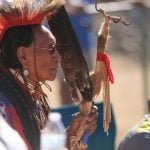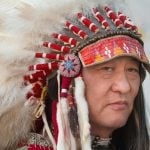Plains Indian Sign Language
During the 18th and 19th centuries, the world of the American Indians who inhabited the Great Plains changed greatly. The first, and perhaps most significant, change began with the adoption of the horse following the Pueblo Revolt of 1680. The horse not only extended the hunting range of the Indian nations which already inhabited the Plains, such as the Blackfoot and Crow, but it also brought a number of newcomers into the area. The increased number of tribes on the Plains not only spoke different languages, but their languages were often totally unrelated.
On the Plains, a sign language developed to allow for trade and easier communication among the many different Indian nations in this area. This sign language seems to have been a pidgin language: it was a second language with a simplified grammar and vocabulary. However, there are some who feel it may have arisen out of a deaf language. Linguists feel that this sign language originally developed in the area of south Texas and the Gulf Coast and then spread north, developing some local variations.
While the Plains sign language was a pidgin language, it is generally seen as an elaborate and efficient form of nonverbal communication. It permitted linguistically alien groups to transmit fairly complex messages. Sign language was the lingua franca for trade among the different tribes. Many of the early European explorers, such as Lewis and Clark, relied heavily upon Plains sign language.
By the nineteenth century Plains Sign Language was used by tribes which spoke more than three dozen languages. Not every individual in the tribe was fluent in sign and there was great variation between the tribes regarding fluency in sign. Some individuals had a vocabulary of 3,500 words while most functioned quite well with a vocabulary of 500 to 1,000 words in sign.
One of the advantages to sign language is that it enabled the people to communicate over fairly long distances. Thus, on the Plains two groups could talk to each other and exchange information before they came within voice range.

Shown above is an 1880 photograph of Rushing Bear illustrating the sign for “now” (Smithsonian collections).
Among the Arapaho, the elders report that at one time all children acquired the use of sign language. They tell of a time when people used sign language most of the time while they spoke Arapaho. They also used it to talk across rooms or large areas during social events.
With regard to tribal proficiency in sign, on the Northern Plains the Crow, the Northern Cheyenne, and the Blackfoot were considered the most proficient, while on the Southern Plains, the Kiowa were considered the best.
While most of the linguist study of Indian sign language has focused on the Plains tribes, there are some suggestions that sign languages also developed independently in other areas. The Plateau Culture Area-the area between the Rocky Mountains and the Cascade mountains that includes western Montana, northern Idaho, eastern Washington, northeastern Oregon, and southeaster British Columbia-appears to have developed its own distinctive sign language prior to the adoption of the horse. Once the Indian nations of the eastern portion of this area had the horse, they began hunting buffalo on the Great Plains, putting them into contact with the Plains tribes. At this time they seem to have adopted the Plains sign language which eventually replaced the Plateau sign language.
In the Southeast, a sign language was developed to facilitate communication among the various nations affiliated with the Creek Confederacy. Little is known about this sign language today.



